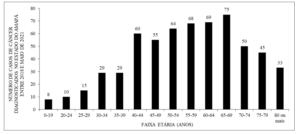ORIGINAL ARTICLE
CHAVES, Ieda Bezerra [1], FECURY, Amanda Alves [2], OLIVEIRA, Euzébio de [3], DENDASCK, Carla Viana [4], DIAS, Claudio Alberto Gellis de Mattos [5]
CHAVES, Ieda Bezerra. et al. Prevalence of sequelae from COVID-19 among students and teachers of the IFAP technical food course in 2022. Revista Científica Multidisciplinar Núcleo do Conhecimento. Year. 07, Ed. 12, Vol. 03, pp. 121-141. December 2022. ISSN: 2448-0959, Access link: https://www.nucleodoconhecimento.com.br/health/technical-food, DOI: 10.32749/nucleodoconhecimento.com.br/health/technical-food
ABSTRACT
COVID-19 is an infectious disease with high transmissibility caused by the SARS-CoV-2 strain of coronavirus. COVID-19 can also cause sequelae (medium and long term), in addition to persistent chronic symptoms after infection. Some of them are olfactory and gustatory, such as anosmia (smell loss), hyposmia (decreased olfactory perception), dysosmia (distorted perception of odors) and dysgeusia (distorted perception of food tastes). The objective of the research was to verify the prevalence of sequelae of COVID-19 among students and professors of the Food technical course of the Instituto Federal de Educação Ciência e Tecnologia do Amapá (IFAP) in 2022. The research has a mixed approach, combining qualitative and quantitative. Women, both students and professors, comprise the largest group of survey respondents (they had COVID-19). There was a higher rate of weak, moderate or no general symptoms among respondents. Most of the analyzed students did not present olfactory and gustatory alteration. Among the teachers, half had a change in smell and most had no change in taste.
Keywords: COVID 19 sequelae, Food, IFAP, Anosmia, Dysgeusia.
INTRODUCTION
COVID-19 is an infectious disease with high transmissibility caused by the coronavirus of the SARS-CoV-2 strain (Coronavirus 2 Severe Acute Respiratory Syndrome), discovered at the end of 2019 (SILVA et al., 2020; SILVA et al., 2020a ; BRASIL, 2021a; OPAS, 2022).
Over the past two years, the scientific community has proven the effectiveness of some protective barrier measures against COVID-19, including: care when coughing and sneezing (respiratory etiquette), hand hygiene, avoiding contact between unwashed hands and the nose and the mouth, maintaining environments with ventilation and natural lighting, cleaning and disinfecting environments, social distancing, use of a face mask in collective places and isolation of suspected cases (BRASIL, 2021; SENHORAS, 2021; SOARES et al., 2021).
The most common manifestations of this disease may include fever, dry cough, dyspnea (shortness of breath), fatigue, sore throat, headache, nasal congestion, diarrhea and smell deficit (anosmia or hyposmia) and taste deficit (ageusia) (CHAVES et al., 2021; OPAS, 2022).
COVID-19 can also cause sequelae (medium and long term), in addition to persistent chronic symptoms after infection (MOURA et al., 2022). The term sequel refers to a change in the behavior of cells, which as a consequence can cause changes that compromise the proper functioning of organs, thus generating permanent dysfunctions or not in the affected individual (CHAVES et al., 2021).
The sequelae described for COVID-19 affect various systems of the human body, such as the respiratory/pulmonary, cardiovascular, nervous, vascular and can generate psychological, skin and gastrointestinal problems. The most frequent disorders are: fatigue, headache, dyspnea, cough, fever, attention deficit, memory loss, pain, palpitations, anxiety, depression, digestive disorders, sleep disorders and olfactory and gustatory dysfunctions (AGUIAR et al., 2021 ; NOGUEIRA et al., 2021; UMPIERRE and KATZ, 2022).
The most common olfactory and gustatory problems have been anosmia (smell loss), hyposmia (decreased olfactory perception), dysosmia (distorted perception of odors) and dysgeusia (distorted perception of food tastes) (CHAVES et al., 2021) (NOGUEIRA et al., 2021; UMPIERRE and KATZ, 2022).
Human sensory organs make it possible to describe certain food products, so sensory analysis is important in the food industry at all stages of production (from conception to quality level assessment). This science encompasses a set of methodologies for evaluating a product through vision, hearing, touch, smell and taste (BIEDRZYCKI, 2008; BENTO et al., 2013).
The sensory sequelae caused by COVID-19 affect the olfactory and gustatory senses to varying degrees, compromising the well-being and daily lives of people who have the disease (CHAVES et al., 2021).
OBJECTIVE
To verify the prevalence of sequelae from COVID-19 among students and professors of the Food technical course at the Instituto Federal de Educação Ciência e Tecnologia do Amapá (IFAP) in 2022.
METHOD
The research has a mixed approach, combining qualitative and quantitative methods was conducted at the Instituto Federal de Educação Ciência e Tecnologia do Amapá (IFAP), Campus Macapá and Campus Santana, in the state of Amapá. The sample, constituted by spontaneous demand, was formed by 38 students and 03 professors of the technical courses of secondary level of food, in the integrated form. For data collection, a questionnaire was used, applied through the Google Forms online questionnaire platform, using a link sent weekly via email. This research followed the criteria of Resolution number 466 of 2012 and number 510 of 2016, of the National Council of Ethics in Research (CONEP)[6], receiving approval according to CAAE 55073821.0.0000.0211.
RESULTS
STUDENTS
Figure 1 shows the percentage of respondent students who had COVID-19 per IFAP full-time integrated food course class. Among these, there were 5.50% in the first year, 18.35% in the second year and 11.01% in the third year.
Figure 1 Shows the percentage of respondent students who had COVID-19 per class of IFAP’s integral integrated food course
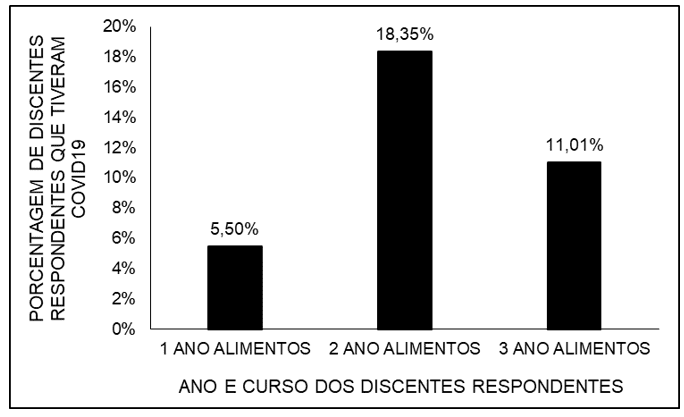
The percentage of responding students who had COVID-19 per IFAP integrated food course class, by biological sex, is shown in figure 2. In the first year, all (15.79%) are women, in the second year, most of the female (39.47%) and male minority (13.16%), and in the third year the most affected biological sex is female (28.95%) and the least affected is male (2.63 %).
Figure 2 Shows the percentage of responding students who had COVID-19 per IFAP full-time integrated food course class, by biological sex
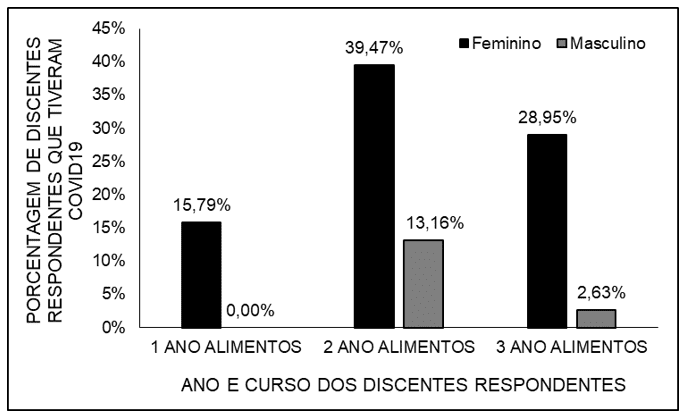
The percentage of student respondents who had COVID-19 per IFAP full integrated food course class, by age group, is distributed between 14 and 22 years old. The age group of 14 years corresponds to the sample of the first year. The 15 years corresponds to a part of the first and second years. The 16-year-old range corresponds to second- and third-year students, while the 17-year-old range includes second- and third-year students. Third-year students are concentrated in the 18-year-old age group. There are still first and second year students in the age groups between 18 and 22 years old (Figure 3).
Figure 3 Shows the percentage of respondent students who had COVID-19 per IFAP full-time integrated food course class, by age group (in years)
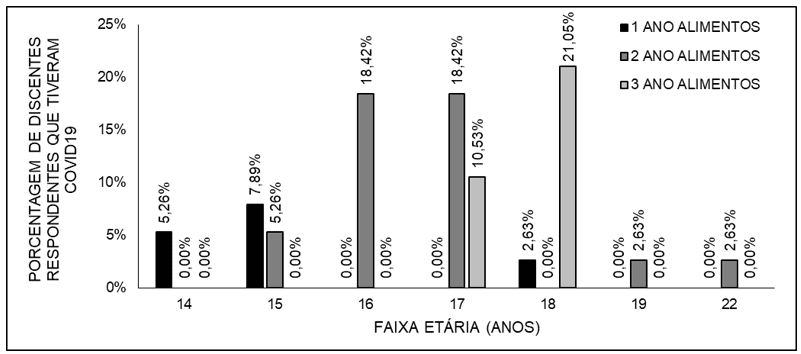
Figure 4 shows the percentage of respondent students who had COVID-19 per IFAP full-time integrated food course class, by symptom intensity. Most had mild symptoms (34.21%), followed by moderate (31.58%) and strong symptoms (13.16%). Many were asymptomatic (21.05%) and none showed symptoms in the most severe form.
Figure 4 Shows the percentage of respondent students who had COVID-19 per IFAP full integrated food course class, by intensity of symptoms
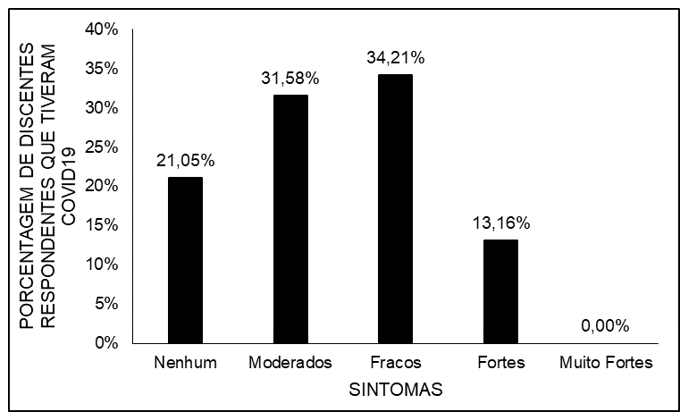
The absolute and relative frequencies of questions about smell answered by students who had COVID-19 per IFAP’s integral integrated food course class are shown in Table 1. Most showed no change in smell (42%), followed by those who showed changes occasional (26%), rare (16%), very common (11%), and common (5%).
The difficulty of smelling things never occurred to 37% of respondents, it was rare in 24%, occasional in 18%, very frequent in 16% and frequent in 5%. Considering the difficulty in eating if they didn’t smell things, 39% said they never felt this problem, 26% frequently, 16% rarely, 11% occasionally, and 8% frequently.
As for the loss of desire/pleasure in eating, half of the respondents (50%) declared that they never lost that feeling, 21% lost it often, 13% very often, 11% rarely, and 5% occasionally.
Chart 1 Shows the absolute and relative frequencies of questions about smell answered by students who had COVID-19 per class of the IFAP integrated course on food
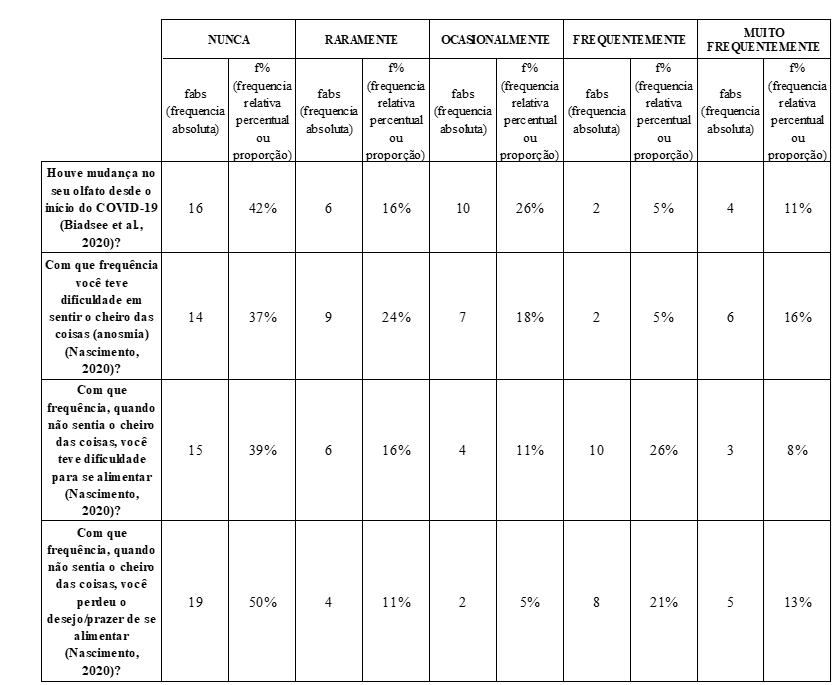
The absolute and relative frequencies of questions about taste answered by students who had COVID-19 per IFAP’s full-time integrated food course class are shown in Table 2. Most showed no change in taste (50%), followed by those who showed changes occasional (18%), very common (13%), frequent (11%), and rare (8%).
The difficulty in eating when there was no taste was never noticed by the majority (45%), it was rare or frequent in the same proportion (21%), it was very frequent in 8%, and occasional in 5%. As for the loss of desire/pleasure in eating when they did not feel the taste, it was never felt by 50% of the respondents, it was rare in 18%, frequent or very frequent in 13% and occasional in 5%.
The change in flavor perception was not felt by most students (spicy 55%, salty 47%, sour and sweet 45%). They were felt occasionally by some (spicy 21%, salty 34%, sour 37%, and sweet 34%), often by less (spicy 08%, salty and sour 13%, and sweet 16%). The very frequent change in the spicy flavor was 03%, and in the salty, sour and sweet flavors it was 05%. This change rarely occurred only in the spicy flavor (13%).
Table 2 Shows the absolute and relative frequencies of questions about taste answered by students who had COVID-19 per class of the IFAP integrated food course
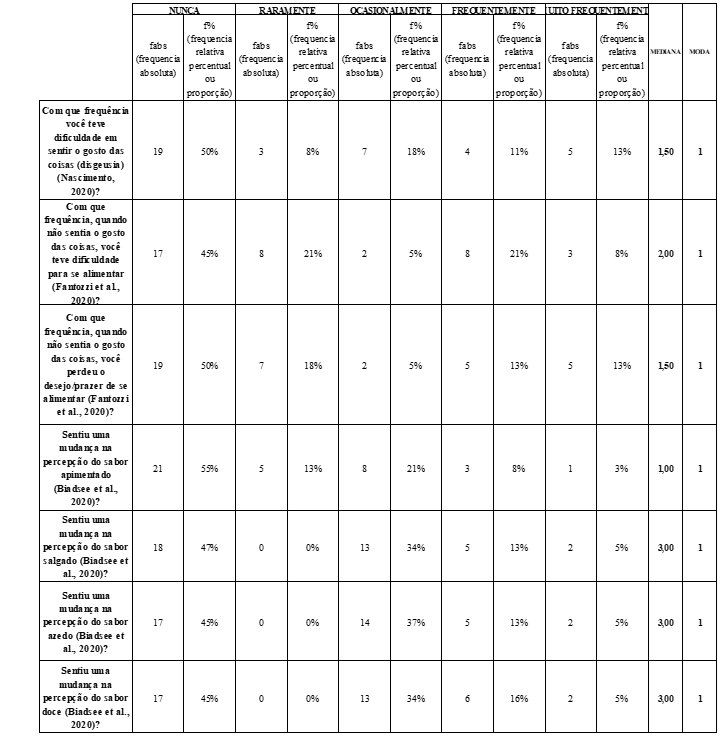
TEACHERS
Table 3 shows the absolute and relative frequencies of IFAP professors, respondents, who had COVID-19, by biological sex, age group and title. Most have female biological sex (66.67%). The age range of the responding teachers is within the range of 30 years. The professors who most responded to the survey had a master’s degree (66.66%) and a minority had a doctorate (33.33%).
Table 3 Shows the absolute and relative frequencies of IFAP professors, respondents, who had COVID-19, by biological sex, age group and title
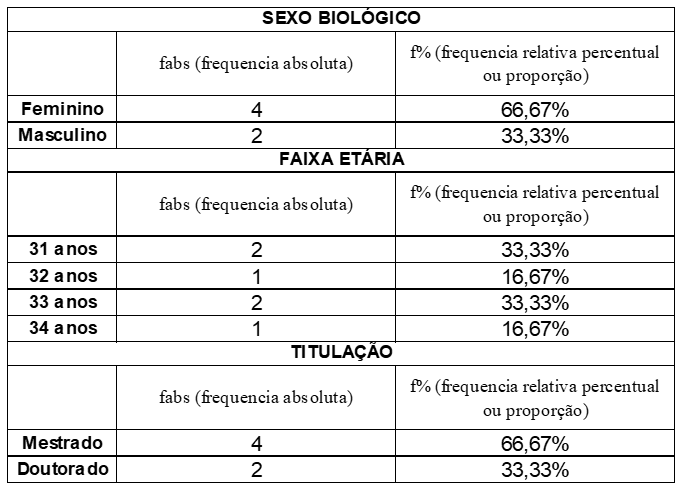
Figure 5 shows the percentage of IFAP professors, respondents, who had COVID-19, by intensity of symptoms. The non-presentation of symptoms or weak and moderate symptoms appear in the same proportion (33.33%). There is no statement about strong or very strong symptoms.
Figure 5 Shows the percentage of IFAP professors, respondents, who had COVID-19, by intensity of symptoms
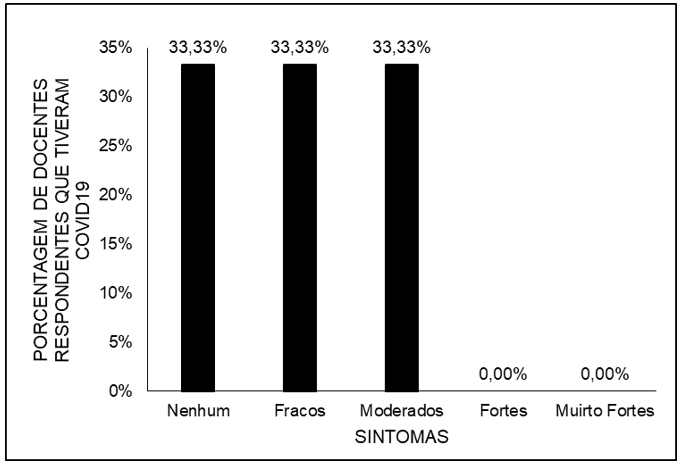
The absolute and relative frequencies of questions about smell, answered by IFAP professors who had COVID-19, appear in Table 4. Half (50%) declared that there was no change in smell, and rare, occasional or frequent changes were reported in the same proportions (17%). There were no reports of very frequent changes. The difficulty in smelling things did not occur in 50% of the professors, was rare in 17%, and was very frequent in 17%.
As for the difficulty of eating due to not smelling things, 83% of the teachers did not have difficulty, however it was very frequent in 17% of them. Pleasure/desire to eat when not smelling things never happened to 67% of respondents, being rare or frequent in 17%.
Chart 4 Shows the absolute and relative frequencies of questions about smell answered by IFAP professors who had COVID-19
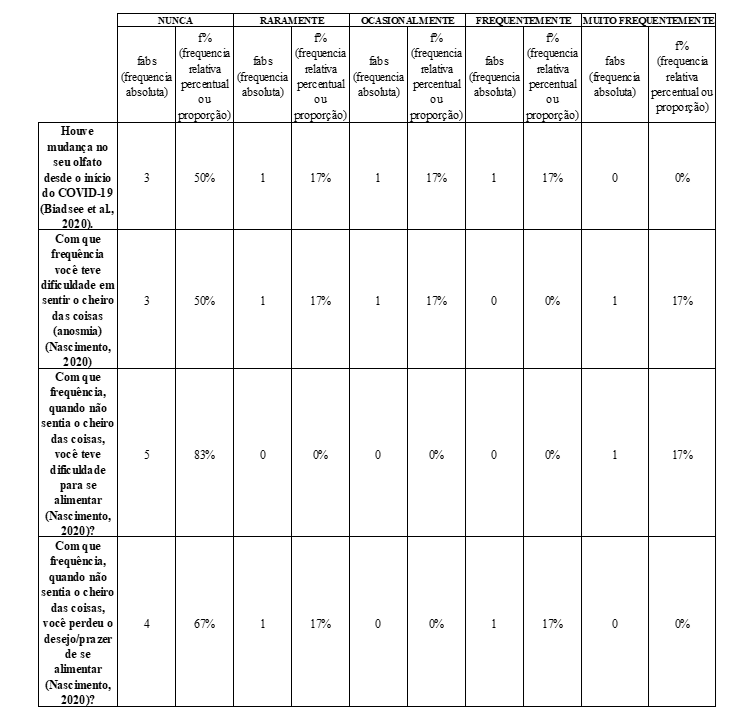
The absolute and relative frequencies of questions about gustation and questions about gustation, answered by IFAP professors who had COVID-19, are shown in Table 5. Most showed no change in taste (83%), followed by those who showed frequent changes ( 17%).
Difficulty in eating without tasting things was not felt by the majority (83%) and was rare in 17%. However, when asked about the loss of desire/pleasure in eating without tasting things, 67% declared not having this problem, in 17% it occurred rarely, but it was frequent in another 17%.
The change in the perception of flavors was not felt by most professors (spicy and sweet 83%, salty and sour 67%). They were experienced rarely by some (spicy and salty 17%), and also frequently (sour and sweet 17%). The occasional change occurred in relation to the sour taste, at a rate of 17%.
Chart 5 Shows the absolute and relative frequencies of questions about taste answered by IFAP professors who had COVID-19
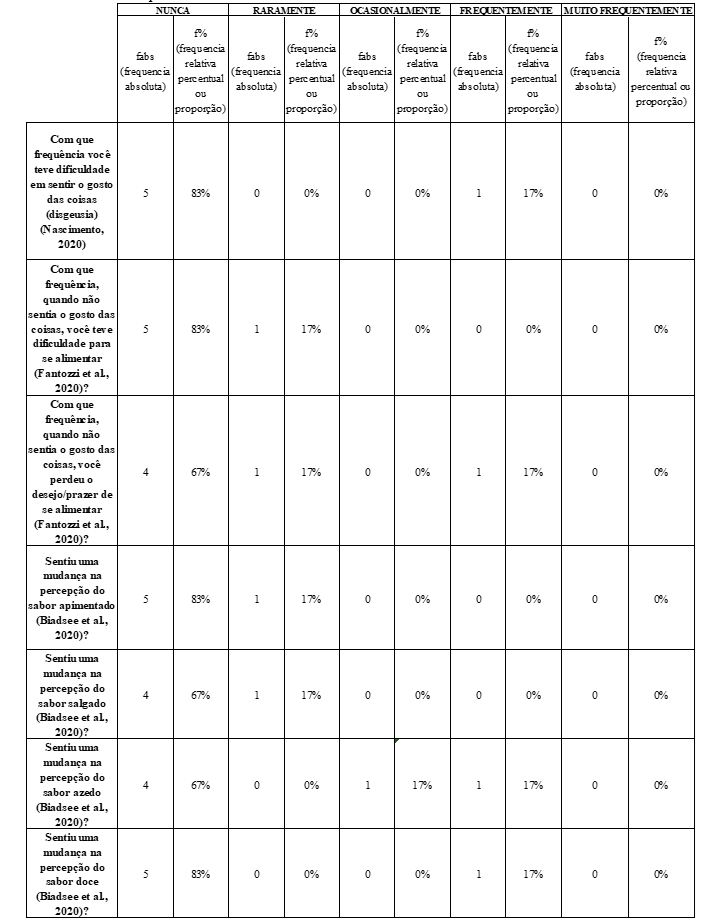
DISCUSSION
It is possible that the school life (at school, on public transport) of young people close to 19 years old, with more life and social contact than pre-adolescents, is the cause of a higher number of adolescents with COVID-19 in the researched course ( NETO et al., 2021).
Women study and work more, this is noticeable through data from 2016, young women aged between 15 and 17 years old had school attendance of 73.5% (high school), while men represented a frequency of 63.2 %. The indices demonstrate that they are increasingly present in relation to the educational aspect and are the majority in professional courses of basic education (CERQUEIRA et al., 2021).
The higher rate of women affected is due to the fact that the food course classes have more women than men. In this way, it becomes evident why the young women add up to a larger group of those affected by the disease in the case of this research. Women are the majority in the Food Engineering course (ANDREOLA and KLANOVICZ, 2013; CUNHA et al., 2020). A study in a federal technological education center also explained the percentage (about 90%) of women in the Food Technology course (KOVALESKI and PILATTI, 2005).
From the data, the occurrence of students between 18 and 22 years old in the 1st and 2nd of high school is observed. In 2018, there were more than 7 million Brazilians in basic education who are included in the age-grade distortion phenomenon: a condition which represents young people with school delay of 2 or more years. These individuals failed or dropped out and returned to school at a stage not proportional to their age (BAUER et al., 2018). The 2021 Census of Basic Education, carried out by the National Instituto Nacional de Estudos e Pesquisas Educacionais Anísio Teixeira (INEP), says that institutions (federal administrative dependency) in the urban area of Amapá present 48.9% of age-grade distortion in high school (BRASIL, 2021b).
Quarantine, decreed by government agencies at the height of the pandemic, together with social isolation, contributed to preventing and slowing down the transmission rate of the COVID-19 virus (SILVA et al., 2020a; SILVA et al., 2021). Several vaccines with proven efficacy in preventing severe cases of COVID-19, hospitalizations and deaths have been developed. Collective vaccination proves to be highly beneficial as it reduces, controls and eradicates several diseases (SERPA et al., 2021; SILVA-FILHO et al., 2021).
The younger population was less affected by the severe manifestations of COVID-19 in relation to the adult and elderly age group. In this sense, children and adolescents had a high proportion of asymptomatic and mild cases, which increases the risk of infection among the rest of the population, in addition, investigations reveal that these groups are less susceptible to the virus (MIRANDA and MORAIS, 2021).
Smell is directly linked to taste, as both work together (NETO et al., 2011; NASCIMENTO, 2020). Therefore, smell is essential for the perception of flavors during eating, appetite stimulation and identification of foods and substances unfit for consumption (PEREIRA, 2020). Thus, both are considered chemical senses, being part of the nervous system, responsible for interconnecting sensations. When they detect the chemical substances, they work together, so that the taste is directly linked to the olfactory perception (NETO et al., 2011; NASCIMENTO, 2021) Thus, the smell plays a crucial role during food in the perception of flavors, in addition to stimulating the appetite, because through the perception of the odor of a food the digestive system provides the production of saliva and gastric juice before the food is ingested. In addition, smell can identify foods and substances unfit for consumption (PEREIRA, 2020).
Smell, like taste, is an important relationship with pleasure at the time of eating, as it enables the activation of the limbic system, linked to emotional memories triggered during the perception of odors and flavors. This association makes it possible to make positive or negative attributions for each odor and associate them with emotions and memories (PEREIRA, 2020; NASCIMENTO, 2021). The absence of smell makes it impossible to properly perceive the flavors of food, which causes loss of appetite and pleasure in eating (NETO et al., 2011).
The olfactory decrease generates negative influences on appetite, leads to inadequate nutrition and, consequently, reduces the quality of life of those affected (GOMES and SANTOS, 2019). Loss of appetite and food pleasure condition individuals with sensory deficits to lose weight or increase consumption of foods with more salt to try to taste the food (PEREIRA, 2020).
The olfactory perception enables the activation of the limbic system (emotions and memories) during food consumption by identifying flavors and odors. If the sense of smell is affected, the proper perception of food flavors is compromised, with loss of pleasure and appetite in food (NETO et al., 2011). This deficit causes weight loss or increased consumption of salty foods to try to taste (PEREIRA, 2020).
Olfactory and taste disorders are related to a wide variety of viral infections (BRITTO et al., 2020; PIMENTEL, 2020). The olfactory nerve is composed of olfactory receptor neurons that connect the nasal cavity to the central nervous system, so viruses can compromise neurological nerves as well as the central nervous system and cause olfactory problems (BRITTO et al., 2020) .
Viral diseases of the upper airways can cause these disorders in varying degrees and durations (COSTA et al., 2020). Olfactory symptoms are a consequence of injury to the olfactory epithelium, which affect non-neural cells, but when they compromise neural cells, the olfactory loss worsens (LIMA et al., 2022).
Olfactory and taste disorders became an indicator of COVID-19 after scientific studies demonstrated this fact, thus several health institutions declared these dysfunctions as symptoms of COVID-19. Countless people affected by the infection developed anosmia (loss of smell), ageusia (loss of taste) and dysgeusia (change in taste), this symptom picture has become common among those infected by the disease (SANTOS et al., 2020). Olfactory (and taste) changes began to signal COVID-19, since several scientific studies have shown that many infected people have developed disorders such as anosmia, ageusia and dysgeusia, and have become common symptoms among those affected by the disease (SANTOS et al., 2020). These individuals also have their quality of life affected, as the dysfunctions compromise mood, pleasure in eating and reduce the ability to detect dangers (NOGUEIRA et al., 2021a).
Olfactory problems are considered factors that affect mood, food pleasure and reduce the ability to detect dangers. In this bias, the various disorders such as the total loss of smell (anosmia), decreased olfactory capacity (hyposmia) and the distortion of the olfactory sense (parosmia) generate discomfort and disorders in the daily lives of people who have these disorders (NOGUEIRA et al., 2021a).
Losing taste means losing smell, because the perception of the taste of food occurs through smell, since most of the perception of the taste of food is provided by smell. During the consumption of a food, aromatic molecules are released that trigger the smell through the connection of the cavity behind the mouth with the nasal passages, therefore, the taste is directly related to the retronasal capacity of perception of odors. Not having your sense of smell affected, therefore, means, in addition to maintaining the ability to distinguish odors, the ability to continue tasting things (FRANCO, 2018).
Taste and smell are related to extrinsic factors of swallowing, as they play an essential role in somatosensory stimulation, which is essential for the central command of transporting food from the mouth to the stomach. In the same way that they relate the feeling of pleasure with food (NASCIMENTO, 2020).
Taste, together with smell, is the sense that provides a relationship between the act of eating and the emotions that activate the limbic system, electrical stimuli are capable of making some regions of this system react, when activated, among numerous sensations, can cause pleasure. When they are compromised, they can generate disinterest and food refusal (RIBEIRO et al., 2021).
Dysfunctions of smell, and consequently, of taste, have become a common manifestation in several cases of COVID-19, such as ageusia (loss of taste) and dysgeusia (alteration of taste), and have started to be reported in scientific research, which is why health agencies included sensory deficits as symptoms of the disease (SANTOS et al., 2020).
The change in taste, as well as smell, causes affected people to lose interest and refuse food, leading to weight loss, malnutrition and nutritional limitations, therefore, that provide transmission and recognition of tastes in specific areas of the brain (NASCIMENTO, 2020).
The perception of flavors (gustatory system) occurs through the stimulation of cell receptors present in the taste buds, which are distributed throughout the oral cavity and have a potential for specifying different flavors. Taste buds have specific receptors for different taste stimuli, which provide the transmission and recognition of flavors in specific areas of the brain (NASCIMENTO, 2020).
A virus, such as COVID 19, can settle in the olfactory tissue, and thus impair the perception of flavors (FRANCO, 2018). The olfactory nerve, composed of olfactory receptor neurons, which connect the nasal cavity to the central nervous system. In this way, viruses can reach neurological nerves, as well as the central nervous system, and cause olfactory problems (BRITTO et al., 2020).
CONCLUSION
Women, both students and professors, comprise the largest group of survey respondents (they had COVID-19). There was a higher rate of weak, moderate or no general symptoms among respondents. Most of the analyzed students did not present olfactory and gustatory alteration. Among the teachers, half had a change in smell and most had no change in taste.
Therefore, it is noted that the group chosen and addressed in this research – students and teachers of the Food course – had a low rate of olfactory and gustatory dysfunction. In order to find out more precisely the individuals who had these disorders, it would be necessary to continue this study, increasing the diversity of locations and the number of respondents.
REFERENCES
AGUIAR, B. F.; SARQUIS, L. M. M.; MIRANDA, F. M. A. Sequelas da COVID-19: uma reflexão sobre os impactos na saúde do trabalhador. Research, Society and Development, v. 10, n. 14, p. e40101421886, 2021.
ANDREOLA, A. L.; KLANOVICZ, L. R. F. Mulheres Nos Cursos De Engenharia Na Universidade Federal Do Paraná E Universidade Federal Do Rio Grande Do Sul. 2013. Disponível em: < https://www.academia.edu/12489197/MULHERES_NOS_CURSOS_DE_ENGENHARIA_NA_UNIVERSIDADE_FEDERAL_DO_PARAN%C3%81_E_UNIVERSIDADE_FEDERAL_DO_RIO_GRANDE_DO_SUL >. Acesso em: 01 dez 2022.
BAUER, F. et al. Panorama da distorção Idade-série do Brasil – 2018. Brasília DF, 2018. Disponível em: < https://www.unicef.org/brazil/media/461/file/Panorama_da_distorcao_idade-serie_no_Brasil.pdf >. Acesso em: 17 out 2022.
BENTO, R. D. A.; ANDRADE, S. A. C.; SILVA, A. M. A. D. Análise sensorial de alimentos. Recife PE: CODAI, 2013. 138p.
BIEDRZYCKI, A. Aplicação da avaliação sensorial no controle de qualidade em uma indústria de produtos cárneos. 2008. 64p. (Graduação). Universidade do Rio Grande do Sul, Porto Alegre RS.
BRASIL. Como se proteger? , Brasília DF, 2021. Disponível em: < https://www.gov.br/saude/pt-br/coronavirus/como-se-proteger >. Acesso em: 29 set 2022.
______. Doenças ocasionadas por vírus respiratórios emergentes, incluindo o COVID-19. Brasília DF, 2021a. Disponível em: < https://www.unasus.gov.br/cursos/curso/46164 >. Acesso em: 29 set 2022.
______. Taxa de distorção idade-série, Brasil, Regiões Geográficas e Unidades da Federação. Brasilia DF, 2021b. Disponível em: < https://www.gov.br/inep/pt-br/acesso-a-informacao/dados-abertos/indicadores-educacionais/taxas-de-distorcao-idade-serie >. Acesso em: 02 dez 2022.
BRITTO, D. B. L. D. A. et al. Achados neurológicos, alterações sensoriais da função olfativa, gustativa e auditiva em pacientes com COVID-19: uma revisão literária. REAS/EJCH, v. 46, n. 46, p. 1-8, 2020.
CERQUEIRA, P. C.; PONTES, E. A. S.; MELO, B. M. A mulher no mundo do trabalho: a escolha do curso “masculino” e a inserção no estágio. Research, Society and Development, v. 10, n. 13, p. 1-11, 2021.
CHAVES, I. B. et al. Sequelas do COVID 19 em gustação e olfato: uma breve revisão bibliográfica. Revista Científica Multidisciplinar Núcleo do Conhecimento, v. 1, n. 11, p. 150-166, 2021. Disponível em: < https://www.nucleodoconhecimento.com.br/saude/sequelas-do-COVID-19 >.
COSTA, K. V. T. D. et al. Desordens olfativas e gustativas na COVID-19: uma revisão sistemática. v. 86, n. 6, p. 781-792, 2020.
CUNHA, U. F. C.; MIRANDA, C. M.; RAMBO, M. K. D. Mulheres nas ciências exatas e tecnologias: um olhar para a Universidade Federal do Tocantins – UFT na perspectiva de gênero. Revista Humanidades e Inovação, v. 7, n. 2, p. 276-289, 2020.
FRANCO, A. L. A. L. Correlação dos sentidos do olfato e paladar entre si e com comportamentos sociais. 2018. 24 p. (Mestrado). Universidade de Lisboa, Lisboa PT.
GOMES, G. D. B.; SANTOS, L. F. O declínio dos sentidos e suas consequências na alimentação dos idosos. 2019. 24 p. (Graduação). Centro Universitário de Brasília, Brasília BR.
KOVALESKI, N. V. J.; PILATTI, L. A. As escolhas de cursos pelas mulheres: qual formação para quais papéis sociais? O caso das estudantes do Centro Federal de Educação Tecnológica do Paraná – Unidade de Ponta Grossa. Revista Gestão Industrial, v. 1, n. 1, p. 89-103, 2005.
LIMA, M. H. D. L. C.; CAVALCANTE, A. L. B.; LEÃO, S. C. Relação fisiopatológica entre COVID-19 e disfunção olfativa: uma revisão sistemática. Brazilian Journal of otorhinolaryngology, v. 88, n. 5, p. 794-802, 2022.
MIRANDA, J. O. F.; MORAIS, A. C. A COVID-19 na vida de crianças e adolescentes brasileiros: poucos sintomas e muitos impactos. Rev. Enferm. Contemp., v. 10, n. 1, p. 6 -7, 2021.
MOURA, D. L. et al. Sequelas da COVID-19 no atleta: evidência atual. In: MOURA, D. L. (Ed.). Biomecânica e traumatologia das modalidades desportivas. Lisboa PT: LIDEL, 2022. p.437-445.
NASCIMENTO, M. A. Alteração das funções sensoriais de olfato e paladar e seus correlatos clínicos e funcionais em indivíduos com COVID-19. 2020. 71p. (Mestrado). Universidade Federal do Rio Grande do Norte, Santa Cruz.
NASCIMENTO, M. A. A alteração das funções sensoriais de olfato e paladar e seus correlatos clínicos e funcionais em indivíduos com COVID-19. 2021. 71 p. (Mestrado). Universidade Federal do Rio Grande do Norte, Santa Cruz BR.
NETO, F. X. P. et al. Anormalidades sensoriais: olfato e paladar. International Archives of Otorhinolaryngology, v. 15, n. 3, p. 350-358, 2011.
NETO, J. C. et al. Análise de indicadores epidemiológicos de crianças e adolescentes acometidos pela COVID- pela COVID-19 no Nordeste do Brasil 19 no Nordeste do Brasil 19 no Nordeste do Brasil Rev. Enferm. UFSM – REUFSM, v. 11, n. 19, p. 1-19, 2021.
NOGUEIRA, J. F. et al. Distúrbios olfatórios decorrentes de infecção por SARS-CoV-2: fisiopatologia, fatores de risco e possíveis intervenções. Research, Society and Development, v. 10, n. 11, p. 1-7, 2021.
NOGUEIRA, T. L. et al. Pós COVID-19: as sequelas deixadas pelo Sars-Cov-2 e o impacto na vida das pessoas acometidas. Archives of Health, v. 2, n. 3, p. 457-471, 2021a.
OPAS. Folha informativa sobre COVID-19. 2022. Disponível em: < https://www.paho.org/pt/COVID19 >. Acesso em: 29 set 2022.
PEREIRA, I. I. C. Relação entre depressão e perda de capacidade olfativa. 2020. 20 p. (Mestrado). Universidade de Lisboa, Lisboa PT.
PIMENTEL, B. N. As disfunções olfativas e gustativas como apresentação clínica da COVID-19. Research, Society and Development, v. 9, n. 8, p. 1-16, 2020.
RIBEIRO, S. C. M. D. S.; FONSECA, P. C.; ADAMI, A. A. V. A relevância da nutrição para reabilitação do paladar e olfato em decorrência da COVID-19. Pouso Alegre MG, 2021. Disponível em: < https://repositorio.animaeducacao.com.br/bitstream/ANIMA/25978/1/TCC%20RUNA.pdf >. Acesso em: 18 out 2022.
SANTOS, I. H. A. et al. Disfunções olfativas e gustativas na COVID-19. Research, Society and Development, v. 9, p. 1-16, 2020.
SENHORAS, E. M. O campo de poder das vacinas na pandemia da COVID-19. Boletim de Conjuntura (BOCA), v. 6, n. 18, p. 110–121, 2021.
SERPA, F. S. et al. Vacinas COVID-19 e imunobiológicos. Arq Asma Alerg Imunol v. 5, n. 2, p. 126-134, 2021.
SILVA-FILHO, P. S. D. P. et al. Vacinas contra Coronavírus (COVID-19; SARS-COV-2) no Brasil: um panorama geral. Research, Society and Development, v. 10, n. 8, p. 1-11, 2021.
SILVA, A. W. C. et al. Caracterização clínica e epidemiologia de 1560 casos de COVID-19 em Macapá/AP, extremo norte do Brasil. Research, Society and Development, v. 9, n. 8, p. 1-21, 2020. Disponível em: < https://rsdjournal.org/index.php/rsd/article/view/5499/4641 >.
SILVA, A. W. C. et al. Perfil epidemiológico e determinante social do COVID-19 em Macapá, Amapá, Amazônia, Brasil. Revista Científica Multidisciplinar Núcleo do Conhecimento, v. 4, n. 05-27, 2020a. Disponível em: < https://www.nucleodoconhecimento.com.br/saude/COVID-19-em-macapa >.
SILVA, C. C. D. et al. Aspectos da origem, fisiopatologia, imunologia e tratamento: uma revisão narrativa. Revista Eletrônica Acervo Saúde, v. 13, n. 3, p. 1-8, 2021.
SOARES, K. H. D. et al. Medidas de prevenção e controle da COVID-19: revisão integrativa. Revista Eletrônica Acervo Saúde, v. 13, n. 3, p. 1-11, 2021.
UMPIERRE, R. N.; KATZ, N. Telecondutas: condições pós-COVID-19. Porto Alegre RS, 2022. Acesso em: 17 OUT 2022.
APPENDIX – FOOTNOTE
6. Conselho Nacional de Ética em Pesquisa (CONEP).
[1] Student of the Integrated Technical High School in Food at the Instituto de Ensino Básico, Técnico e Tecnológico do Amapá (IFAP). Scientific Initiation Student at GP MESPTeAm IFAP (2021-2022).
[2] Biomedical, PhD in Tropical Diseases, Professor and researcher at the Campus Macapá Medicine Course, Universidade Federal do Amapá (UNIFAP), and at the Programa de Pós-graduação em Ciências da Saúde (PPGCS UNIFAP), Pro-Rector of Research and Postgraduate Graduation (PROPESPG) from the Universidade Federal do Amapá (UNIFAP).
[3] Biologist, PhD in Tropical Diseases, Professor and researcher at the Physical Education Course at the Universidade Federal do Pará (UFPA).
[4] PhD in Psychology and Clinical Psychoanalysis. Doctorate in progress in Communication and Semiotics from the Pontifícia Universidade Católica de São Paulo (PUC/SP), Master’s Degree in Religious Sciences from Universidade Presbiteriana Mackenzie. Master in Clinical Psychoanalysis. Degree in Biological Sciences. Degree in Theology. He has been working with Scientific Methodology (Research Method) for more than 15 years in Scientific Production Guidance for Master’s and Doctoral Students. Specialist in Market Research and Health Research.
[5] Biologist, PhD in Theory and Research of Behavior, Professor and researcher at the Instituto de Ensino Básico, Técnico e Tecnológico do Amapá (IFAP), the Programa de Pós Graduação em Educação Profissional e Tecnológica (PROFEPT IFAP) and the Programa de Pós Graduação em Biodiversidade e Biotecnologia da Rede BIONORTE (PPG-BIONORTE), Amapá hub.
Sent: December, 2022.
Approved: December, 2022.















